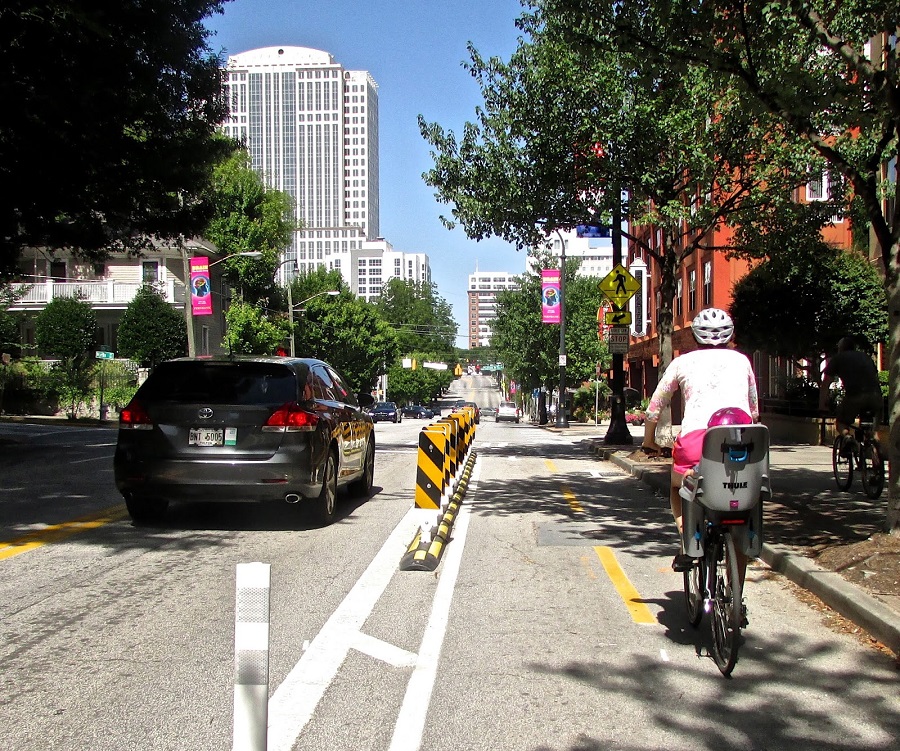
Atlanta invest $1 Billion to Bike-Friendly-Cities Projects
Look out, cycling-happy locales: Atlanta is putting $1 billion into biking and walking over 25 years, and targeting your place in the rankings of bike-friendly cities.

When we talk about “bike-friendly cities,” Atlanta isn’t usually one of the first metros mentioned—nor has it ever found a spot on our biannual Top 50 rankings. Known more for its car-centric urban sprawl and gridlocked tangle of highways, the Georgia capital has long been a tough place to navigate on two wheels.
But that could be changing. In 2013, Mayor Kasim Reed announced plans for Atlanta to become a top-10 cycling city—a goal that seemed a tad ambitious when he gave it a timeline of three years. But now that the 2016 deadline is here, the wheels are finally in motion: The Atlanta Regional Commission has approved a $1 billion plan to make the area safer for cyclists and pedestrians.
Again, that’s a ONE-BILLION-DOLLAR plan to make the city safer for human-powered transport. That would be great news anywhere, but in Atlanta it could go a long way toward securing the capital a coveted new reputation as a city that bikes.
The ‘Walk. Bike. Thrive!’ plan will roll out over the next 25 years and bring more bike lanes, sidewalks, and multi-use projects to communities in the metro that could use those most. Byron Rushing, the bicycling & pedestrian planner for the Atlanta Regional Commission, is optimistic but practical about what it could mean for Atlanta.
That $1 billion, he notes, is only a small slice of the $85 billion 25-year transportation budget for the Atlanta metro region—though it is a significant increase in the portion allotted to biking and walking in years past. He says this will be the first time the city has developed a comprehensive trail plan that seeks to connect communities and the big multi-use paths—like the Silver Comet trail to Alabama, and the 22-mile Beltline around the city’s core.
Rushing says the money will also be used to help the many smaller cities that make up the Atlanta metro become more bike-friendly. He’s not harboring any big fantasy that a city built around car travel will shift overnight, but a belief that nuanced changes in communities can encourage more people to walk and bike.
“It probably sounds too big to say, ‘We want to start changing that history of suburban sprawl across metro Atlanta,’ but we want to make a dent in that—where it makes sense and where the opportunities show themselves,” he says. “Maybe we can’t tackle all those 30-mile commutes from one side of the metro to the other, but it could be a situation where kids can start riding or walking to school, or people can walk to their community’s Main Street. We’re trying to meet people in the communities they’re at right now.”
Rushing says the board voted unanimously to approve the new bike plan. Although many of the members voting live in regions of the city that “haven’t had a big investment in cycling historically,” he says, most had looked around the country and seen what cycling and pedestrian investment had done for other cities—and what it could do for metro Atlanta’s problems, like congestion, air quality, and declining public health.
Dallas, Toronto, Chicago, Philadelphia—Atlanta transit officials had visited all of them, and all had benefited from vast improvements in their walking and cycling infrastructure.
“We’re always big on learning from other cities,” Rushing says. “Nowhere do we go in the country right now where people aren’t talking about bicycling, walking, and regional transit. It brings out our competitive spirit.”
Good luck, Atlanta! We’re pulling for you to make a debut in this year’s ranking of top bike-friendly cities.
If you’d like to learn more about how the region will use the new plan to become a friendlier region for bikes, check out metro Atlanta’s six-part strategy.
Source: http://www.bicycling.com/news/advocacy/atlanta-puts-1-billion-toward-biking-and-walking-projects?cid=soc_BICYCLING%20magazine%20-%20bicyclingmag_FBPAGE_Bicycling__